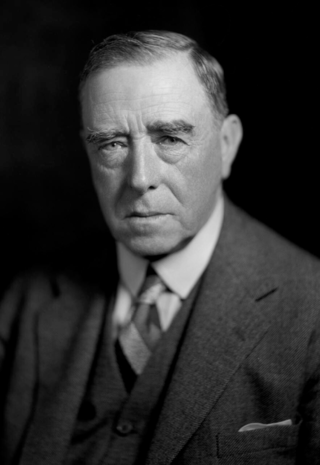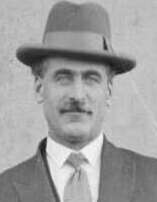Politics of the Australian state of Victoria takes place in the context of a constitutional monarchy with a bicameral parliamentary system, and like other Australian states, Victoria is part of the federation known as the Commonwealth of Australia.

Sir Rupert James "Dick" Hamer, was an Australian politician who served as the 39th premier of Victoria from 1972 to 1981, and prior to that, the 18th deputy premier of Victoria from 1971 to 1972. He held office as the leader of the Victorian division of the Liberal Party of Australia (LPA) and a member of the Victorian Legislative Assembly (MLA) for the division of Kew.

The Victorian Legislative Assembly is the state lower house of the bicameral Parliament of Victoria in Australia; the state upper house being the Victorian Legislative Council. Both houses sit at Parliament House in Spring Street, Melbourne. The main colour used for the upholstery and carpets furnishing the Chamber of the Legislative Assembly is green.

The Victorian Legislative Council is the upper house of the bicameral Parliament of Victoria, Australia, the lower house being the Legislative Assembly. Both houses sit at Parliament House in Spring Street, Melbourne. The Legislative Council serves as a house of review, in a similar fashion to its federal counterpart, the Australian Senate. Although it is possible for legislation to be first introduced in the Council, most bills receive their first hearing in the Legislative Assembly.

Thomas Tuke Hollway was the 36th Premier of Victoria, and the first to be born in the 20th century. He held office from 1947 to 1950, and again for a short period in 1952. He was originally a member and the leader of the United Australia Party (UAP) in Victoria, and was the inaugural leader of the UAP's successor, the Victorian division of the Liberal Party, but split from the Liberals after a dispute over electoral reform issues.

The 1996 Victorian state election, held on Saturday, 30 March 1996, was for the 53rd Parliament of Victoria. It was held in the Australian state of Victoria to elect all 88 members of the state's Legislative Assembly and 22 members of the 44-member Legislative Council. The election took place four weeks after the 1996 federal election which swept the Labor Party from power nationally.

The 1992 Victoria state election, held on Saturday, October 3. was for the 52nd Parliament of Victoria. It was held in the Australian state of Victoria to elect all 88 members of the state's Legislative Assembly and 22 members of the 44-member Legislative Council.

The 1988 Victorian state election, held on Saturday, 1 October 1988, was for the 51st Parliament of Victoria. It was held in the Australian state of Victoria to elect all 88 members of the state's Legislative Assembly and 22 members of the 44-member Legislative Council.

The 2006 Victorian state election, held on Saturday, 25 November 2006, was for the 56th Parliament of Victoria. Just over 3 million Victorians registered to vote elected 88 members to the Legislative Assembly and, for the first time, 40 members to the Legislative Council under a proportional representation system. The election was conducted by the independent Victorian Electoral Commission.

Elections were held in the Australian state of Victoria on 27 June 1964 to elect the 66 members of the state's Legislative Assembly and 17 members of the 34-member Legislative Council. The Liberal and Country Party (LCP) government of Premier Henry Bolte won a fourth term in office.

The 1970 Victorian state election, held on Saturday, 30 May 1970, was for the 45th Parliament of Victoria. It was held in the Australian state of Victoria to elect the 73 members of the state's Legislative Assembly and 18 members of the 36-member Legislative Council.

Elections were held in the Australian state of Victoria on Saturday 29 April 1967 to elect the 73 members of the state's Legislative Assembly and 18 members of the 36-member Legislative Council.

Elections were held in the Australian state of Victoria on Saturday 31 May 1958 to elect the 66 members of the state's Legislative Assembly. This was the last time Assembly elections were held separately from those for the Legislative Council.

The 1955 Victorian state election was held in the Australian State of Victoria on Saturday, 28 May 1955 to elect 65 members of the state's Legislative Assembly.

The 1932 Victorian state election was held in the Australian state of Victoria on Saturday 14 May 1932 to elect 44 of the 65 members of the state's Legislative Assembly. The other 21 seats were uncontested.

Cr. George Tomas Gahan JP was an Australian politician and Victorian amateur boxer. He was born in Inglewood, Victoria to Benjamin Edward Gahan and Emma Gahan née Walker. The Gahan family later moved to the Melbourne suburb of Prahran where George became a building contractor. At a young age George began training as an amateur boxer. In his mid 30s Gahan attempted to join the Australian Army and defend his country in World War II. Despite being rejected by army due to a duodenal ulcer, Gahan applied a second time, only be to turned away again. This tenacious streak proved to be a valuable attribute as George again turned his focus towards amateur boxing, winning a Yarraville boxing competition and in 1949 in the final of the Welter division was beaten by the Australian champion Bill Seewitz. George had his last fight at 42 years of age when he was stopped in the 2nd round by his opponent 20 years his junior. George's tenacity and fighting talent soon shifted from the boxing ring to the political arena, becoming known as Prahran's George the Giant Killer. From 1957 to 1959, George Gahan was the president of the Prahran-South Yarra branch of the Helping Hand League of Victoria; now known as Inclusion Melbourne.

Major Sir Thomas Karran Maltby was a politician in Victoria, Australia. He was a member of the Victorian Legislative Assembly for nearly 32 years from 1929 to 1961, served in several ministries and was Speaker of the assembly from 1947 to 1950.

The 1927 Victorian state election was held in the Australian state of Victoria on Saturday, 9 April 1927, to elect the 65 members of the state's Legislative Assembly.

The Victorian Labor Party, officially known as the Australian Labor Party and commonly referred to simply as Victorian Labor, is the Victorian state branch of the Australian Labor Party (ALP). The party forms the incumbent government in the state of Victoria and is led by Jacinta Allan, who has served concurrently as Premier of Victoria since 2023.

The Victorian Liberal Party, officially known as the Liberal Party of Australia (Victorian Division) and branded as Liberal Victoria, is the state division of the Liberal Party of Australia in Victoria. It was formed in 1949 as the Liberal and Country Party (LCP) and simplified its name to the Liberal Party in 1965. The party sits on the centre-right to right-wing of the Australian political spectrum, and is currently led by Brad Battin.
















